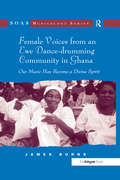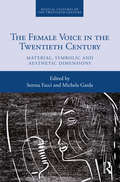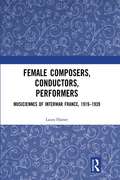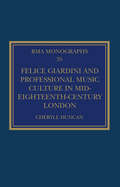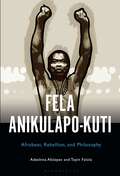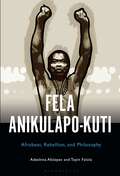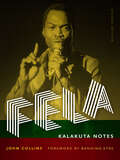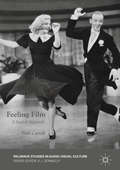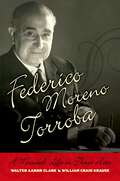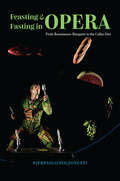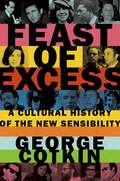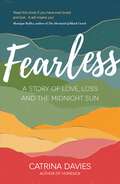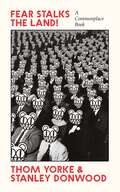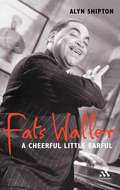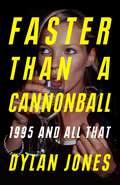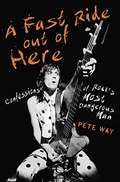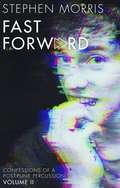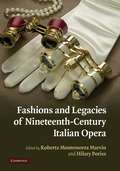- Table View
- List View
Female Voices from an Ewe Dance-drumming Community in Ghana: Our Music Has Become a Divine Spirit
by James BurnsEwe dance-drumming has been extensively studied throughout the history of ethnomusicology, but up to now there has not been a single study that addresses Ewe female musicians. James Burns redresses this deficiency through a detailed ethnography of a group of female musicians from the Dzigbordi community dance-drumming club from the rural town of Dzodze, located in South-Eastern Ghana. Dzigbordi was specifically chosen because of the author's long association with the group members, and because it is part of a genre known as adekede, or female songs of redress, where women musicians critique gender relations in society. Burns uses audio and video interviews, recordings of rehearsals and performances and detailed collaborative analyses of song texts, dance routines and performance practice to address important methodological shifts in ethnomusicology that outline a more humanistic perspective of music cultures. This perspective encompasses the inter-linkages between history, social processes and individual creative artists. The voices of Dzigbordi women provide us not only with a more complete picture of Ewe music-making, they further allow us to better understand the relationship between culture, social life and individual creativity. The book will therefore appeal to those interested in African Studies, Gender Studies and Oral Literature, as well as ethnomusicology. Includes a DVD documentary.
Female Voices from an Ewe Dance-drumming Community in Ghana: Our Music Has Become a Divine Spirit
by James BurnsEwe dance-drumming has been extensively studied throughout the history of ethnomusicology, but up to now there has not been a single study that addresses Ewe female musicians. James Burns redresses this deficiency through a detailed ethnography of a group of female musicians from the Dzigbordi community dance-drumming club from the rural town of Dzodze, located in South-Eastern Ghana. Dzigbordi was specifically chosen because of the author's long association with the group members, and because it is part of a genre known as adekede, or female songs of redress, where women musicians critique gender relations in society. Burns uses audio and video interviews, recordings of rehearsals and performances and detailed collaborative analyses of song texts, dance routines and performance practice to address important methodological shifts in ethnomusicology that outline a more humanistic perspective of music cultures. This perspective encompasses the inter-linkages between history, social processes and individual creative artists. The voices of Dzigbordi women provide us not only with a more complete picture of Ewe music-making, they further allow us to better understand the relationship between culture, social life and individual creativity. The book will therefore appeal to those interested in African Studies, Gender Studies and Oral Literature, as well as ethnomusicology. Includes a DVD documentary.
The Female Voice in the Twentieth Century: Material, Symbolic and Aesthetic Dimensions (Musical Cultures of the Twentieth Century)
by Serena Facci Michela GardaBy integrating theoretical approaches to the female voice with the musicological investigation of female singers’ practices, the contributors to this volume offer fresh viewpoints on the material, symbolic and cultural aspects of the female voice in the twentieth century. Various styles and genres are covered, including Western art music, experimental composition, popular music, urban folk and jazz. The volume offers a substantial and innovative appraisal of the role of the female voice from the perspective of twentieth-century performance practices, the centrality of female singers’ experimentations and extended vocal techniques along with the process of the ‘subjectivisation’ of the voice.
The Female Voice in the Twentieth Century: Material, Symbolic and Aesthetic Dimensions (Musical Cultures of the Twentieth Century)
by Serena Facci and Michela GardaBy integrating theoretical approaches to the female voice with the musicological investigation of female singers’ practices, the contributors to this volume offer fresh viewpoints on the material, symbolic and cultural aspects of the female voice in the twentieth century. Various styles and genres are covered, including Western art music, experimental composition, popular music, urban folk and jazz. The volume offers a substantial and innovative appraisal of the role of the female voice from the perspective of twentieth-century performance practices, the centrality of female singers’ experimentations and extended vocal techniques along with the process of the ‘subjectivisation’ of the voice.
Female Composers, Conductors, Performers: Musiciennes of Interwar France, 1919-1939
by Laura HamerDrawing upon extensive archival research, interview material, and musical analysis, Female Composers, Conductors, Performers: Musiciennes of Interwar France, 1919–1939 presents an innovative study of women working as professional musicians in France between the two World Wars. Hamer positions the activities, achievements, and reception of women composers, conductors, and performers against a contemporary socio-political climate that was largely hostile to female professionalism. The musical styles and techniques of Marguerite Canal, Jeanne Leleu, Germaine Tailleferre, Yvonne Desportes, Elsa Barraine, and Claude Arrieu are discussed with reference to significant works dating from the interwar period. Hamer highlights the activities of Jane Evrard and her Orchestre féminin de Paris as well as the reception of the Orchestra of the Union des Femmes Professeurs et Compositeurs de Musique, a contemporary pro-suffrage organisation that was dedicated to defending the collective interests of musiciennes and campaigning for their employment rights. Beyond women composers and conductors, Hamer also sheds light on female performers and their contribution to the interwar early music revival.
Female Composers, Conductors, Performers: Musiciennes of Interwar France, 1919-1939
by Laura HamerDrawing upon extensive archival research, interview material, and musical analysis, Female Composers, Conductors, Performers: Musiciennes of Interwar France, 1919–1939 presents an innovative study of women working as professional musicians in France between the two World Wars. Hamer positions the activities, achievements, and reception of women composers, conductors, and performers against a contemporary socio-political climate that was largely hostile to female professionalism. The musical styles and techniques of Marguerite Canal, Jeanne Leleu, Germaine Tailleferre, Yvonne Desportes, Elsa Barraine, and Claude Arrieu are discussed with reference to significant works dating from the interwar period. Hamer highlights the activities of Jane Evrard and her Orchestre féminin de Paris as well as the reception of the Orchestra of the Union des Femmes Professeurs et Compositeurs de Musique, a contemporary pro-suffrage organisation that was dedicated to defending the collective interests of musiciennes and campaigning for their employment rights. Beyond women composers and conductors, Hamer also sheds light on female performers and their contribution to the interwar early music revival.
Felice Giardini and Professional Music Culture in Mid-Eighteenth-Century London (Royal Musical Association Monographs)
by Cheryll DuncanFelice Giardini and Professional Music Culture in Mid-Eighteenth-Century London explores Giardini’s influence on British musical life through his multifaceted career as performer, teacher, composer, concert promoter and opera impresario. The crux of the study is a detailed account of Giardini’s partnership with the music seller/publisher John Cox during the 1750s, presented using new biographical information which contextualizes their business dealings and subsequent disaccord. The resulting litigation, the details of which have only recently come to light, is explored here via a complex set of archival materials. The findings offer new information about the economics of professional music culture at the time, including detailed figures for performers’ fees, the printing and binding of music scores, the charges arising from the administration of concerts and operas, the sale, hire and repair of various instruments and the cost of what today we would call intellectual property rights. This is a fascinating study for musicologists and followers of Giardini, as well as for readers with an interest in classical music, social history and legal history.
Felice Giardini and Professional Music Culture in Mid-Eighteenth-Century London (Royal Musical Association Monographs)
by Cheryll DuncanFelice Giardini and Professional Music Culture in Mid-Eighteenth-Century London explores Giardini’s influence on British musical life through his multifaceted career as performer, teacher, composer, concert promoter and opera impresario. The crux of the study is a detailed account of Giardini’s partnership with the music seller/publisher John Cox during the 1750s, presented using new biographical information which contextualizes their business dealings and subsequent disaccord. The resulting litigation, the details of which have only recently come to light, is explored here via a complex set of archival materials. The findings offer new information about the economics of professional music culture at the time, including detailed figures for performers’ fees, the printing and binding of music scores, the charges arising from the administration of concerts and operas, the sale, hire and repair of various instruments and the cost of what today we would call intellectual property rights. This is a fascinating study for musicologists and followers of Giardini, as well as for readers with an interest in classical music, social history and legal history.
Fela Anikulapo-Kuti: Afrobeat, Rebellion, and Philosophy
by Adeshina Afolayan Toyin FalolaFela Anikulapo Kuti was the Afrobeat music maestro whose life and time provide the lens through which we can outline the postcolonial trajectory of the Nigerian state as well as the dynamics of most other African states. Through the Afrobeat music, Fela did not only challenge consecutive governments in Nigeria, but his rebellious Afrobeat lyrics facilitate a philosophical subtext that enriches the more intellectual Afrocentric discourses. Afrobeat and the philosophy of blackism that Fela enunciated place him right beside Malcolm X, Kwame Nkrumah, Marcus Garvey, and all the others who champion a black and African mode of being in the world. This book traces the emergence of Fela on the music scene, the cultural and political backgrounds that made Afrobeat possible, and the philosophical elements that not only contributed to the formation of Fela's blackism, but what constitutes Fela's philosophical sensibility too.
Fela Anikulapo-Kuti: Afrobeat, Rebellion, and Philosophy
by Adeshina Afolayan Toyin FalolaFela Anikulapo Kuti was the Afrobeat music maestro whose life and time provide the lens through which we can outline the postcolonial trajectory of the Nigerian state as well as the dynamics of most other African states. Through the Afrobeat music, Fela did not only challenge consecutive governments in Nigeria, but his rebellious Afrobeat lyrics facilitate a philosophical subtext that enriches the more intellectual Afrocentric discourses. Afrobeat and the philosophy of blackism that Fela enunciated place him right beside Malcolm X, Kwame Nkrumah, Marcus Garvey, and all the others who champion a black and African mode of being in the world. This book traces the emergence of Fela on the music scene, the cultural and political backgrounds that made Afrobeat possible, and the philosophical elements that not only contributed to the formation of Fela's blackism, but what constitutes Fela's philosophical sensibility too.
Fela: Kalakuta Notes (Music / Interview)
by John CollinsFela: Kalakuta Notes is an evocative account of Fela Kuti—the Afrobeat superstar who took African music into the arena of direct action. With his antiestablishment songs, he dedicated himself to Pan-Africanism and the down-trodden Nigerian masses, or "sufferheads." In the 1970s, the British/Ghanaian musician and author John Collins met and worked with Fela in Ghana and Nigeria. Kalakuta Notes includes a diary that Collins kept in 1977 when he acted in Fela's autobiographical film, Black President. The book offers revealing interviews with Fela by the author, as well as with band members, friends, and colleagues. For this second edition, Collins has expanded the original introduction by providing needed context for popular music in Africa in the 1960s and the influences on the artist's music and politics. In a new concluding chapter, Collins reflects on the legacy of Fela: the spread of Afrobeat, Fela's musical children, Fela's Shrine and Kalakuta House, and the annual Felabration. As the dust settles over Fela's fiery, creative, and controversial career, his Afrobeat groove and political message live on in Kalakuta Notes. Features a new foreword by Banning Eyre, an up-to-date discography by Ronnie Graham, a timeline, historical photographs, and snapshots by the author.
Feeling Film: A Spatial Approach (Palgrave Studies in Audio-Visual Culture)
by Beth CarrollThis book questions the de facto dominance of narrative when watching films. Using the film musical as a case study, this book explores whether an alternative spatial understanding of film can offer alternative readings to narrative. For instance, how do film aesthetics influence our interaction with the film? Can camera movement and music make us ‘feel’ cinema? Can the film world bleed into our own? Utilising film musicals ranging from those by Fred Astaire and Ginger Rogers to von Trier’s Dancer in the Dark (2000), Feeling Film: A Spatial Approach investigates how we might go about understanding the audience's spatial relationship with film aesthetics, what it might look like, and the tools needed to conduct analysis.
Feel Good 101: The Outsiders' Guide to a Happier Life
by Emma BlackeryThe Sunday Times BestsellerTHIS BOOK WON'T CHANGE YOUR LIFEBut it might just help you change it yourselfOnly you can take the steps you need to help yourself become the strong, independent, fearless person you dream of being. It took me a long time - and a lot of real lows, excruciating heartaches and countless mistakes - to get there. The sole purpose of this book's existence is the hope that it may speed up that journey to happiness for you.In FEEL GOOD 101, YouTube's most outspoken star Emma Blackery is finally putting pen to paper to (over)share all her hard-learned life lessons. From standing up to bullies and bad bosses to embracing body confidence and making peace with her brain, Emma speaks with her trademark honesty about the issues she's faced - including her struggles with anxiety and depression. This is the book Emma wishes she'd had growing up . . . and she's written it for you.
Federico Moreno Torroba: A Musical Life in Three Acts (Currents in Latin American and Iberian Music)
by Walter Aaron Clark William Craig KrauseThe last of the Spanish Romantics, composer, conductor, and impresario Federico Moreno Torroba (1891-1982) left his mark on virtually every aspect of Spanish musical culture during a career that spanned six decades and saw tremendous political and cultural upheavals. After Falla, he was the most important and influential musician: in addition to his creative activities, he was President of the General Society of Authors and Editors and director of the Academy of Fine Arts. His enduring contributions as a composer include dozens of guitar works composed for Andrés Segovia and several highly successful zarzuelas, which remain in the repertoire today. Written by two leading experts in the field, Federico Moreno Torroba: A Musical Life in Three Acts explores not only his life and work, but also the relationship of his music to the cultural milieu in which he moved. It sheds particular light on the relationship of Torroba's music and the cultural politics of Francisco Franco's dictatorship (1939-75). Torroba came of age during a cultural renaissance that sought to reassert Spain's position as a unique cultural entity, and authors Walter A. Clark and William Krause demonstrate how his work can be understood as a personal, musical response to these aspirations. Clark and Krause argue that Torroba's decision to remain in Spain even during the years of Franco's dictatorship was based primarily not on political ideology but rather on an unwillingness to leave his native soil. Rather than abandon Spain to participate in the dynamic musical life abroad, he continued to compose music that reflected his conservative view of his national and personal heritage. The authors contend that this pursuit did not necessitate allegiance to a particular regime, but rather to the non-political exaltation of Spain's so-called "eternal tradition," or the culture and spirit that had endured throughout Spain's turbulent history. Following Franco's death in 1975, there was ambivalence towards figures like Torroba who had made their peace with the dictatorship and paid a heavy price in terms of their reputation among expatriates. Moreover, his very conservative musical style made him a target for the post-war avant-garde, which disdained his highly tonal and melodic españolismo. With the demise of high modernism, however, the time has come for this new, more distanced assessment of Torroba's contributions. Richly illustrated with photographs and musical examples, and with a helpful chronology and works list for reference, this biography brings a fresh perspective on this influential composer to Latin American and Iberian music scholars, performers, and lovers of Spanish music alike.
Federico Moreno Torroba: A Musical Life in Three Acts (Currents in Latin American and Iberian Music)
by Walter Aaron Clark William Craig KrauseThe last of the Spanish Romantics, composer, conductor, and impresario Federico Moreno Torroba (1891-1982) left his mark on virtually every aspect of Spanish musical culture during a career that spanned six decades and saw tremendous political and cultural upheavals. After Falla, he was the most important and influential musician: in addition to his creative activities, he was President of the General Society of Authors and Editors and director of the Academy of Fine Arts. His enduring contributions as a composer include dozens of guitar works composed for Andrés Segovia and several highly successful zarzuelas, which remain in the repertoire today. Written by two leading experts in the field, Federico Moreno Torroba: A Musical Life in Three Acts explores not only his life and work, but also the relationship of his music to the cultural milieu in which he moved. It sheds particular light on the relationship of Torroba's music and the cultural politics of Francisco Franco's dictatorship (1939-75). Torroba came of age during a cultural renaissance that sought to reassert Spain's position as a unique cultural entity, and authors Walter A. Clark and William Krause demonstrate how his work can be understood as a personal, musical response to these aspirations. Clark and Krause argue that Torroba's decision to remain in Spain even during the years of Franco's dictatorship was based primarily not on political ideology but rather on an unwillingness to leave his native soil. Rather than abandon Spain to participate in the dynamic musical life abroad, he continued to compose music that reflected his conservative view of his national and personal heritage. The authors contend that this pursuit did not necessitate allegiance to a particular regime, but rather to the non-political exaltation of Spain's so-called "eternal tradition," or the culture and spirit that had endured throughout Spain's turbulent history. Following Franco's death in 1975, there was ambivalence towards figures like Torroba who had made their peace with the dictatorship and paid a heavy price in terms of their reputation among expatriates. Moreover, his very conservative musical style made him a target for the post-war avant-garde, which disdained his highly tonal and melodic españolismo. With the demise of high modernism, however, the time has come for this new, more distanced assessment of Torroba's contributions. Richly illustrated with photographs and musical examples, and with a helpful chronology and works list for reference, this biography brings a fresh perspective on this influential composer to Latin American and Iberian music scholars, performers, and lovers of Spanish music alike.
Feasting and Fasting in Opera: From Renaissance Banquets to the Callas Diet
by Pierpaolo PolzonettiFeasting and Fasting in Opera shows that the consumption of food and drink is an essential component of opera, both on and off stage. In this book, opera scholar Pierpaolo Polzonetti explores how convivial culture shaped the birth of opera and opera-going rituals until the mid-nineteenth century, when eating and drinking at the opera house were still common. Through analyses of convivial scenes in operas, the book also shows how the consumption of food and drink, and sharing or the refusal to do so, define characters’ identity and relationships. Feasting and Fasting in Opera moves chronologically from around 1480 to the middle of the nineteenth century, when Wagner’s operatic reforms banished refreshments during the performance and mandated a darkened auditorium and absorbed listening. The book focuses on questions of comedy, pleasure, embodiment, and indulgence—looking at fasting, poisoning, food disorders, body types, diet, and social, ethnic, and gender identities—in both tragic and comic operas from Monteverdi to Puccini. Polzonetti also sheds new light on the diet Maria Callas underwent in preparation for her famous performance as Violetta, the consumptive heroine of Verdi’s La traviata. Neither food lovers nor opera scholars will want to miss Polzonetti’s page-turning and imaginative book.
Feast of Excess: A Cultural History of the New Sensibility
by George CotkinIn 1952, John Cage shocked audiences with 4'33", his compositional ode to the ironic power of silence. From Cage's minimalism to Chris Burden's radical performance art two decades later (in one piece he had himself shot), the post-war American avant-garde shattered the divide between low and high art, between artist and audience. They changed the cultural landscape. Feast of Excess is an engaging and accessible portrait of "The New Sensibility," as it was named by Susan Sontag in 1965. The New Sensibility sought to push culture in extreme directions: either towards stark minimalism or gaudy maximalism. Through vignette profiles of prominent figures-John Cage, Patricia Highsmith, Allen Ginsberg, Andy Warhol, Anne Sexton, John Coltrane, Bob Dylan, Erica Jong, and Thomas Pynchon, to name a few-George Cotkin presents their bold, headline-grabbing performances and places them within the historical moment. This inventive and jaunty narrative captures the excitement of liberation in American culture. The roots of this release, as Cotkin demonstrates, began in the 1950s, boomed in the 1960s, and became the cultural norm by the 1970s. More than a detailed immersion in the history of cultural extremism, Feast of Excess raises provocative questions for our present-day culture.
Feast of Excess: A Cultural History of the New Sensibility
by George CotkinIn 1952, John Cage shocked audiences with 4'33", his compositional ode to the ironic power of silence. From Cage's minimalism to Chris Burden's radical performance art two decades later (in one piece he had himself shot), the post-war American avant-garde shattered the divide between low and high art, between artist and audience. They changed the cultural landscape. Feast of Excess is an engaging and accessible portrait of "The New Sensibility," as it was named by Susan Sontag in 1965. The New Sensibility sought to push culture in extreme directions: either towards stark minimalism or gaudy maximalism. Through vignette profiles of prominent figures-John Cage, Patricia Highsmith, Allen Ginsberg, Andy Warhol, Anne Sexton, John Coltrane, Bob Dylan, Erica Jong, and Thomas Pynchon, to name a few-George Cotkin presents their bold, headline-grabbing performances and places them within the historical moment. This inventive and jaunty narrative captures the excitement of liberation in American culture. The roots of this release, as Cotkin demonstrates, began in the 1950s, boomed in the 1960s, and became the cultural norm by the 1970s. More than a detailed immersion in the history of cultural extremism, Feast of Excess raises provocative questions for our present-day culture.
Fearless: A Story of Love, Loss and The Midnight Sun
by Catrina DaviesFearlessness has got nothing to do with being unafraid. It’s about doing things anyway, getting on with it, living, whether you’re afraid or not. Fuzzy-haired, free-spirited, cello-playing Catrina is devastated when her lover, Jack, leaves her to go surfing on the other side of the world. Trapped in a dead-end job and torn by his departure, she dreams of running away. But how do you run away when you’re flat broke? Luckily, her friend Andrew comes up with a plan: they’ll get an old van, turn it into a camper and busk their way from Norway to Portugal, via Nordkapp, the land of the Midnight Sun.When a tragic accident occurs, the journey suddenly takes on new meaning. As she navigates personal loss and the daily challenges of life on the road, Catrina begins to learn the true meaning of love and courage and, above all else, the importance of following her dreams.This is an unforgettable story of a journey like no other – a deeply emotional and inspirational debut by a unique writer.
Fear Stalks the Land!: A Commonplace Book
by Stanley Donwood Thom YorkeIn which the writings of the authors Thom Yorke and Stanley Donwood are gathered together. This commonplace book includes faxes, notes, fledgling lyrics, sketches, lists of all kinds and scribblings towards nirvana, as were sent between the two authors during the period 1999 to 2000 during the creation of the Radiohead albums Kid A and Amnesiac. This is a document of the creative process and a mirror to the fears, portents and fantasies invoked by the world as its citizens faced a brave new millennium.
Fats Waller: The Cheerful Little Earful
by Alyn ShiptonFats Waller (1904-1943) was an outsize man in all respects: five feet, eleven inches tall, he weighed 285 pounds. The greatest of the Harlem "stride" pianists, he composed hundreds of songs, he led a band that made over 400 recordings, and he wrote several Broadway shows. Waller's gargantuan appetites have been celebrated in anecdotes and earlier biographies. He is seen by jazz historians as a man of immense musical talent that was never fulfilled. In this fully revised and updated biography of Waller, Alyn Shipton re-examines his career, arguing that his talents as a songwriter, show composer, and brilliant recording and broadcasting artist have not been fully appreciated. In a newly written final chapter, there is a comprehensive survey of Waller's recordings as they have been reissued for the CD era.
Faster Than A Cannonball: 1995 and All That
by Dylan JonesDecades tend to crest halfway through, and 1995 was the year of the Nineties: peak Britpop (Oasis v Blur), peak YBA (Tracey Emin's tent), peak New Lad (when Nick Hornby published High Fidelity, when James Brown's Loaded detonated the publishing industry, and when pubs were finally allowed to stay open on a Sunday). It was the year of The Bends, the year Danny Boyle started filming Trainspotting, the year Richey Edwards went missing, the year Alex Garland wrote The Beach, the year Blair changed Clause IV after a controversial vote at the Labour Conference. Not only was the mid-Nineties perhaps the last time that rock stars, music journalists and pop consumers held onto a belief in rock's mystical power, it was a period of huge cultural upheaval - in art, literature, publishing and drugs. And it was a period of almost unparalleled hedonism, a time when many people thought they deserved to live the rock and roll lifestyle, when a generation of narcotic omnivores thought they could all be rock stars just by buying a magazine and a copy of (What's the Story) Morning Glory? Faster Than a Cannonball is a cultural swipe of the decade from loungecore to the rise of New Labour, teasing all the relevant artistic strands through interviews with all the major protagonists and exhaustive re-evaluations of the important records of the year - The Bends by Radiohead, Grand Prix by Teenage Fanclub, Maxinquaye by Tricky, Different Class by Pulp, The Great Escape by Blur, It's Great When You're Straight... Yeah! by Black Grape, Exit Planet Dust by the Chemical Brothers, I Should Coco by Supergrass, Elastica by Elastica, Pure Phase by Spiritualized, ...I Care Because You Do by Aphex Twin and of course (What's the Story) Morning Glory by Oasis, the most iconic album of the decade.
A Fast Ride Out of Here: Confessions of Rock's Most Dangerous Man
by Paul Rees Pete Way'They call me a madman but compared to Pete Way, I'm out of my league.' - Ozzy OsbourneThere are rock memoirs and then there is this one. A Fast Ride Out of Here tells a story that is so shocking, so outrageous, so packed with excess and leading to such uproar and tragic consequences as to be almost beyond compare. Put simply, in terms of jaw-dropping incident, self-destruction and all-round craziness, Pete Way's rock'n'roll life makes even Keith Richards's appear routine and Ozzy Osbourne seem positively mild-mannered in comparison. Not for nothing did Nikki Sixx, bassist with LA shock-rockers Motley Crue and who 'died' for eight minutes following a heroin overdose in 1988, consider that he was a disciple of and apprenticed to Way.During a forty-year career as founding member and bassist of the venerated British hard rock band UFO, and which has also included a stint in his hell-raising buddy Ozzy's band, Pete Way has both scaled giddy heights and plunged to unfathomable lows. A heroin addict for more than ten years, he blew millions on drugs and booze and left behind him a trail of chaos and carnage. The human cost of this runs to six marriages, four divorces, a pair of estranged daughters and two dead ex-wives. Latterly, Way has fought cancer, but has survived it all and is now ready to tell his extraordinary tale. By turns hilarious, heart-rending, mordant, scabrous, self-lacerating, brutally honest and entirely compulsive, A Fast Ride Out of Here will be a monument to rock'n'roll debauchery on an epic, unparalleled scale and also to one man's sheer indestructability.
Fast Forward: Confessions of a Post-Punk Percussionist: Volume II
by Stephen MorrisIconic drummer Stephen Morris presses play once more to the tune of the long-awaited second volume of memoirs . . .Poised on the brink of success, the dizzying heights of the unknown lying ahead, Ian Curtis had taken his own life. Grieving yet determined, Stephen Morris emerged from the wreckage of Joy Division to the dawn of something new: a new band, a new tour, a new beginning. Under the name New Order, Morris and his bandmates set their sights on America, only to encounter new disasters. Yet, in true northern spirit, not even this sudden tragedy could dissuade them from following their haphazard path to greatness.Following the highs and lows of New Order, Fast Forward tracks the changing rhythm of Morris's life and the music that shaped it. From 'music differences' to the ever-growing Joy Division legacy, music is the constant beat through the verses of Fast Forward as Morris's personal and professional life grew increasingly intertwined. This came to a head when his girlfriend was invited to join the band. Tentatively stepping into their testosterone-filled world, Gillian was the right person at the right time for New Order. And for Morris. What began as just a trial period in the band spun into a whirlwind of new projects and experiences, including The Other Two - a project born during one of New Order's (many) hiatuses.Blending entertaining anecdote with profound reflection, Fast Forward strips back a lifetime of fame and fortune to tell, with raw honesty, how New Order threatened to implode time after time. And yet, despite everything, the legacy of their music continued to hold them together.
Fashions and Legacies of Nineteenth-Century Italian Opera (PDF)
by Edited by Roberta M. Marvin Hilary PorissOperatic works by Italian composers of the nineteenth century have undergone countless transformations since their premieres, shifting shape in response to a variety of new geographic, temporal, technological, and performative contexts. These enduring works by Rossini, Donizetti, Bellini, Verdi, Puccini, and their contemporaries have myriad stories to tell. Fashions and Legacies reconstructs a selection of these stories, exploring ways in which operatic works have been reshaped and revived throughout the nineteenth, twentieth, and twenty-first centuries. While focusing on how these works have been altered, the twelve contributors in this book also respond to fundamental questions: how has this music retained – or sacrificed – its powerful messages in the face of deconstruction and recontextualization over time and place? What happens to these operas once they have escaped control of their authors? The contributions of singers, stage directors, conductors, and other theatrical personalities stand front and center of the volume.
